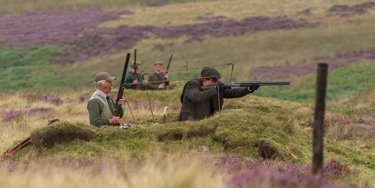The Left Bans Key Game Management Technique in Northern England
England Sinking into the Sea, Environmentalism, Grouse Shooting, Heather Burning Ban, Left-wing Intolerance

Crazy left-wing busybodies rule the world. Didn’t you know? If there is anything going on that useful, productive, or merely fun, they’ve got Environmentalism to use to get their way. Essentially anything human beings do can be argued to produce changes in the world, and any changes can be claimed to be somehow, in some sense, negative. Voilà ! Mustn’t offend Gaia! That’s been banned!
Driven grouse shooting in England & Scotland is not only a sport. It’s also an economic activity. The sale of wild game was banned early in the last century in the United States. Market hunters were responsible for the eradication of the buffalo and the near extinction of some other species, and they competed with sport hunters. In Britain, on the other hand, game bird management on enormous estates included harvesting by sportsmen followed by commercial sale. British restaurants compete to offer red grouse the soonest after the shooting season opens on the traditional date of August 12th.
The goo-goos have all these rationalizations about heather-burning being bad for the environment, but they are all anti-blood sports, and enviromentalism always provides excuses for lefties to nobble things they don’t like, from timber-harvesting to grouse shooting.
The Guardian is gloating.
The controversial practice of setting heather-covered moorland on fire – often carried out by gamekeepers to create more attractive habitats for grouse – is now banned on more than 30 major tracts of land in northern England. Three large landowners have confirmed that their tenants are no longer allowed to burn heather routinely.
The ban is a blow to grouse shoots, which burn older heather to make way for younger, more nutritious plants for grouse to feed on, but environmental groups say the practice harms the environment. Research by the University of Leeds has found that burning grouse moors degrades peatland habitat, releases climate-altering gases, reduces biodiversity and increases flood risk.
Last year, the Observer reported that Yorkshire Water was reviewing each of its grouse-shooting leases amid concerns about the practice of routine burning. The company says has written into its lease a presumption against burning as a land management technique.
United Utilities is also altering its leases to shorter terms, with a similar review to Yorkshire Water’s expected. Last month, it confirmed to the campaign group Ban Bloodsports on Yorkshire’s Moors (BBYM) that it now prohibits routine burning on its land.
And three estates overseen by the National Trust – Marsden, Braithwaite Hall and Dark Peak – also told the group that tenants were no longer allowed to conduct routine burning. Braithwaite Hall said tenants required written consent to do so, and that it had taken legal action against one. Dark Peak said it retained complete control of burning practices on its land. Marsden said tenants could not carry out any burning.
A National Trust spokeswoman said: “We don’t allow burning on deep peat and over recent years have moved away from using controlled grouse-moor burning as a matter of course. There are a diminishing number of historic agreements where burning may occasionally be used but we are working with these tenants to introduce more sustainable land-management practice.â€




